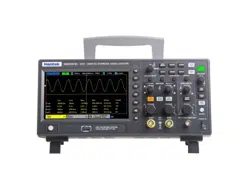Loading ...
Loading ...
Loading ...

User Manual
48 / 68
corresponding to the eight vertical grids on the screen with the selected volt/div (turn the volt/div knob).
2.12. Acquire
2.12.1. Run Control
Press the [Run/Stop] or [Single] button on the front panel to run or stop the sampling system of the scope.
When the [Run/Stop] is green, the oscilloscope is running, that is, acquiring data when trigger conditions are met. To stop
acquiring data, press the [Run/Stop] button. When stopped, the last acquired waveform is displayed.
When the [Run/Stop] button is red, data acquisition is stopped. Red "Stop" is displayed next to the trademark logo in the status
line at the top of the display. To start acquiring data, press [Run/Stop].
To capture and display a single acquisition (whether the oscilloscope is running or stopped), press [Single] button. The Single
run control lets you view single-shot events without subsequent waveform data overwriting the d isplay.
When [Single] is pressed, the display is cleared, the trigger mode is temporarily set to Normal (to keep the oscilloscope from
auto-triggering immediately), the trigger circuitry is armed, the Single key is illuminated, and the oscilloscope waits until a
user defined trigger condition occurs before it displays a waveform.
When the oscilloscope triggers, the single acquisition is displayed and the oscilloscope is stopped (the [Run/Stop] button is
illuminated in red). Press [Single] button again to acquire another waveform.
When you acquire an analog signal, the oscilloscope will convert it into a digital one. The real-time acquisition has four modes:
Normal, Peak Detect, Average and High Resolution. The acquisition rate is affected by the setting of time base.
Normal: In this acquisition mode, the oscilloscope samples the signal in evenly spaced intervals to establish the waveform.
This mode accurately represents signals in most time. However, it does not acquire rapid variations in the analog signal that
may occur between two samples, which can result in aliasing and may cause narrow pulses to be missed. In such cases, you
should use the Peak Detect mode to acquire data.
Peak Detect: In this acquisition mode, the oscilloscope gets the maximum and minimum values of the input signal over each
sample interval and uses these values to display the waveform. In this way, the oscilloscope can acquire and display those
narrow pulses that may have otherwise been missed in Normal mode. However, noise will appear to be higher in this mode.
Average: In this acquisition mode, the oscilloscope acquires several waveform, averages them, and displays the resulting
waveform. You can use this mode to reduce random noise.
High Resolution (HR): This mode uses a kind of ultra-sample technique to average the neighboring points of the sample
waveform to reduce the random noise on the input signal and generate much smoother waveform on the screen. This is generally
used when the sample rate of the digital converter is higher than the storage rate of the acquisition memory.
Note: "Average" and "HR" modes use different averaging methods. The former uses "Multi-sample Average" and the latter
uses "Single Sample Average".
Time Base: The oscilloscope digitizes waveform by acquiring the value of an input signal at discrete points. The time base
helps to control how often the values are digitized. Use the SEC/DIV knob to adjust the time base to a horizontal scale that
suits your purpose.
Push the UTILITY button and press Acquire softkey to set the acquisition parameter.
Loading ...
Loading ...
Loading ...
